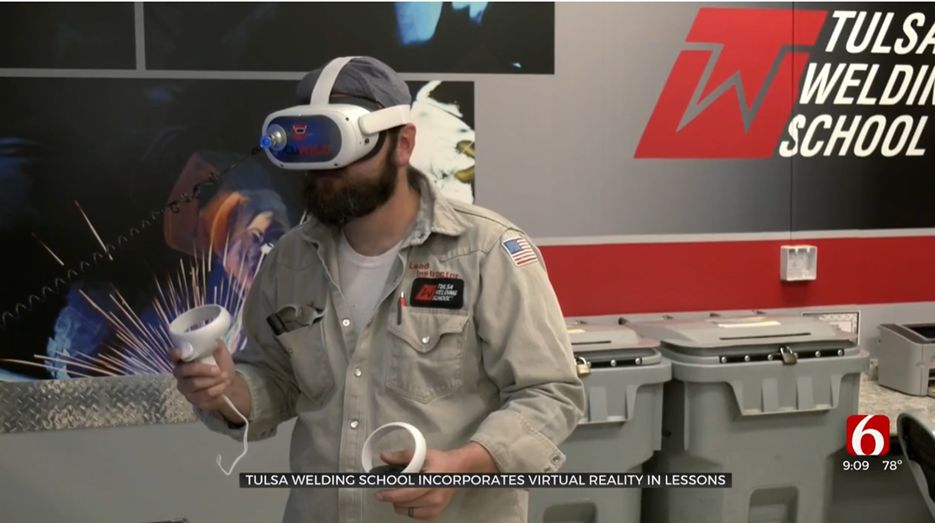
The rapid advancement of virtual reality is transforming our world.
And virtual reality is changing welding as well.
Welders train to gain the specialized skills, knowledge, and qualifications needed to succeed in the field.
Although this standard remains, state-of-the-art VR technology is changing the way this technical training looks.
Gaining a better understanding of virtual welding training, what it offers to students, and where it stands out from traditional programs can help you, an aspiring welder, figure out what training in this field looks like.
Have You Considered a Career in the Skilled Trades?
Fill out the form to recieve a no obligation info packet.
What is virtual reality welding training?
VR welding training uses advanced virtual reality technology to create an immersive and hyper-realistic environment where students can practice real-world welding skills without actually using real equipment.
Gloves, VR headsets, haptic-feedback devices, and other welding simulator components work together to construct life-like virtual environments. .
Welding VR training allows students and instructors to keep track of various metrics:
- Body position
- Arc speed
- Weld quality
- Machine setup
VR technology has been in development for years but is just now finding a place in welding training programs. This recent adoption is due in part to the technology’s improvement in quality, affordability, and accessibility. VR welding might just be the future of welding training overall.
What are the benefits of VR welding training?
Eliminates training injuries.
Welders need to follow strict safety standards to protect themselves against the various hazards faced on the job site, such as toxic fumes, scorching materials, and blinding light.
Of course, a competent welding school will have instructors who prioritize the safety of students. But what’s great about welding VR students can learn without any of the risks.
Provides holistic training.
An advanced welding simulator provides students with a hyper-realistic environment, where they can become trained in all aspects of the welding trade.
Before students even pick up their simulated welding torches, VR training can help them understand how to choose the right welding material, the optimal gas flow setting, the precise voltage, and the correct amperage.
Makes learning fun.
Like all skilled trades, welding is a challenging profession to master. Students have to train in a wide range of welding techniques and strategies before entering the field as qualified welders.
Virtual reality welding also “gamifies” the training program. By assigning scores to certain aspects of a weld such as speed and accuracy, students can accurately track their progress just like in a video game. This scoring system also allows trainees to compete against each other.
Saves real-world materials.
Welding education focuses heavily on hands-on training so students can gain real-world experience.
When dealing with physical materials, students deal with the hassle of starting from scratch even when making a small mistake. Welding VR training avoids this problem altogether by providing students with experiential training in a virtual environment, where no materials are wasted and starting from the beginning is as easy as clicking a few buttons.
Facilitates out-of-classroom learning.
Some welding simulators are only available on-site at trade schools, but the most advanced welding VR technology is completely portable.
For example, the OcuWeld system offered by Tulsa Welding School (TWS) is self-contained in an Oculus Quest 2 headset. This provides students with completely autonomous VR training that can take place in the comfort of their own homes or anywhere else. Students can easily and efficiently supplement their in-classroom learning with real-world training at any time.
Who offers virtual reality welding training?
Virtual reality welding is a highly advanced training technique that has yet to see widespread adoption across the industry. Despite its variety of benefits, it’s only available in a limited number of locations in the country.
Tulsa Welding School offers OcuWeld as an addition tool in a welding student’s toolkit. OcuWeld was specially designed for welding students by experienced welding professionals and instructors. It offers world-class welding training without the safety concerns, material cost, and limitations of standard training techniques. OcuWeld supplements TWS’ comprehensive welding training program.
Interested in learning more about welding training? Read about different training options to see which is the best path for you.
This blog has been labeled as archived as it may no longer contain the most up-to-date data. For a list of all current blog posts, please visit our blog homepage at https://www.tws.edu/blog/




